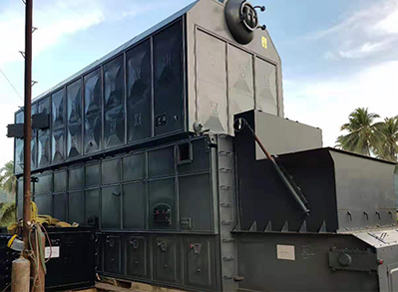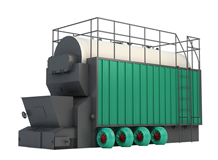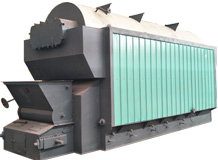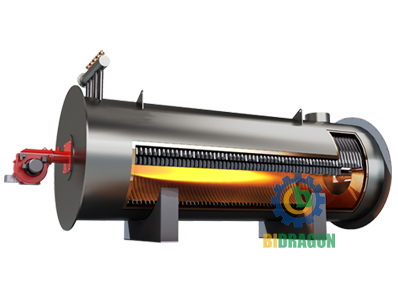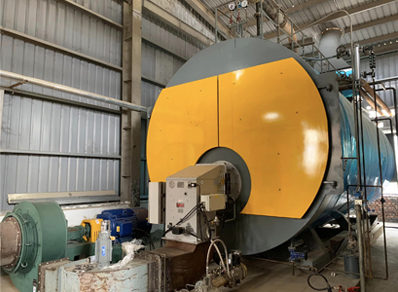
10 Ways to Increase Boiler Efficiency
Boiler efficiency is critical in all types of industries and business scenarios. Not only does it affect energy costs and environmental footprint, it also plays a key role in overall operational performance. So, how can you improve boiler efficiency? Next, we'll dive into a series of proven methods.
The Right Air-Fuel Ratio
For efficient combustion, the right air-to-fuel ratio is essential. When there is too little air, it can cause a number of problems. The carbon in the fuel cannot be fully oxidized, resulting in the formation of carbon monoxide. This not only results in less heat being released because the fuel is not completely burned, but also reduces fuel efficiency. At the same time, low air levels produce soot, smoke and carbon monoxide, all of which are dangerous. However, more air is not better; too much air can also reduce efficiency and result in wasted heat.
It should be noted that in some facilities, the temperature of the air drawn into the burner varies seasonally. This requires more frequent commissioning of the burner to adjust for different air temperatures to maximize energy savings.
Effect of Ambient Temperature and Relative Humidity
Ambient temperature and humidity have a significant impact on the operating efficiency of a boiler. In most standard efficiency calculations, it is common to assume an ambient temperature of 80°F (approximately 26.7°C) and a relative humidity of 30%. However, in actual operation, ambient conditions tend to fluctuate widely, resulting in changes in boiler efficiency.
Studies have shown that boiler efficiency can change by more than 0.5% for every 20°F (~11.1°C) increase or decrease in ambient temperature. This is because changes in temperature affect the density of the incoming air, which changes the thermodynamic characteristics of the combustion process. In addition, the moisture content of the air (relative humidity) can have a similar effect on boiler efficiency. The higher the humidity, the greater the moisture content of the air, resulting in a lower concentration of oxygen entering the combustion chamber, which affects combustion efficiency and may increase fuel consumption.
Therefore, during boiler operation and maintenance, changes in ambient temperature and humidity need to be fully considered and reasonable adjustment measures taken, such as optimizing combustion control, adjusting air preheater parameters or adopting more efficient combustion technologies, in order to maximize the thermal efficiency of the boiler and reduce energy consumption.
Furnace Side and Water Side Inspection
Keeping the furnace side and water side in good condition facilitates heat exchange. For efficient heat exchange, it is critical to keep the furnace side and water side in optimal condition. Scale and soot buildup can reduce heat transfer efficiency and increase fuel consumption. It is recommended that the boiler be scheduled for open, clean and shutdown operations once a year to ensure optimal boiler performance. This helps to remove scale and soot buildup in a timely manner, maintaining heat exchange efficiency and guaranteeing efficient boiler operation.
Thorough Chemical Water Treatment
Water treatment protects heat transfer surfaces and maintains efficient boiler operation. If the heat transfer surfaces of a steam boiler system are poorly maintained, efficiency can be drastically reduced. For example, a scaled boiler can lose up to 20% of its efficiency, and in some cases, the time required to remove scale is equal to the time it takes for scale to build up. If left untreated, an otherwise energy efficient and expensive system can suffer from corrosion, component damage and increased energy costs.
Monitoring Boiler Stack Temperatures
Fuel gas, or boiler stack temperature, refers to the temperature of the combustion gases as they leave the boiler. This temperature represents the majority of the energy that is not converted to usable output. The higher the temperature, the less energy is converted to output and the less efficient the boiler will be.
When evaluating the stack temperature, it is important to determine if this value is accurate. For example, a boiler fueled by natural gas with a stack temperature of 350°F has a maximum theoretical efficiency of 83.5%. For the boiler to be 84% efficient, the stack temperature must be less than 350° F. Therefore, it is critical to accurately monitor and verify the stack temperature value to improve boiler efficiency.
Adjusting the Fuel
The calorific value of a fuel is an important measure of its energy-releasing capacity and determines the total amount of heat that can be released per unit mass of fuel during combustion. Generally speaking, the higher the calorific value of a fuel, the more energy it releases during combustion, helping to improve the thermal efficiency of the boiler. However, the moisture content of the fuel has a significant impact on the actual available calorific value and combustion performance.
Fuel with high moisture content consumes a large amount of heat for water evaporation during combustion, which not only reduces the combustion temperature, but may also affect the stability and completeness of combustion, leading to an increase in incompletely burned combustibles, and thus reducing the overall combustion efficiency of the boiler. In addition, moisture in the fuel may exacerbate the problem of ash and slagging inside the boiler, affecting heat transfer, and even reacting with minerals at high temperatures to form low-melting-point deposits that can clog the heating surface and increase boiler maintenance costs.
In addition, the high moisture content in the fuel can exacerbate the risk of corrosion in the boiler equipment. Water vapor generated during combustion may combine with acid gases such as sulfur oxides in the flue gas to form acidic condensate, which can cause corrosion of the boiler heating surface, flue and other metal parts, shorten the service life of the boiler, and increase maintenance and replacement costs.
Therefore, in the process of boiler operation and fuel selection, the fuel with high calorific value and low moisture content should be selected as far as possible in order to improve combustion efficiency, reduce energy consumption, and reduce equipment losses. At the same time, fuel pretreatment (such as drying or blending) and optimized combustion control strategies can be used to reduce the adverse effects of high-moisture fuels and ensure the efficient and stable operation of the boiler system.
Enhance Insulation
Enhancing the insulation performance of the boiler system is an important part of improving its operating efficiency. Good insulation measures can reduce heat loss, so that more heat energy is retained in the system, thereby improving fuel utilization, reducing energy consumption, and improving the overall thermal efficiency of the boiler.
Heat loss from the boiler system occurs mainly on the surfaces of the piping, boiler body, valves and other key components. If these parts are not insulated properly, the heat will continue to dissipate into the surrounding environment, resulting in the boiler needing to consume more fuel to maintain the set temperature, thus reducing the operational efficiency of the system. Therefore, the use of highly efficient insulation materials to provide a comprehensive thermal insulation cover for the boiler system, such as high-temperature-resistant ceramic fibers, aluminosilicate insulation or advanced composite insulation coatings, can effectively reduce heat transfer losses and improve the system's thermal energy utilization.
Good boiler and heating system insulation not only helps to reduce heat loss, but also reduces the frequency of boiler start-ups and stops, improves equipment life, and significantly reduces heating costs. Especially in cold climates, optimizing the insulation structure of the boiler room and piping can avoid unnecessary heat loss, thus ensuring the stability and economy of the heating system.
To further optimize the insulation effect of the boiler system, companies can regularly check the integrity of the insulation layer and repair or replace aged insulation materials in a timely manner. At the same time, the combination of intelligent temperature monitoring and heat recovery technology can achieve more accurate energy efficiency management, maximize the operating efficiency of the boiler system, reduce energy waste, and achieve the goal of energy saving and emission reduction.
Upgrading Boiler Systems
Upgrading old boiler systems can improve energy efficiency, reduce operating costs and introduce advanced technologies. Addressing the inefficiencies inherent in older systems is critical to avoid escalating energy costs and frequent maintenance challenges. Modern boiler systems are designed to be more energy efficient, often achieving savings of more than 30% compared to older systems.
Reducing Scale and Deposits
Reducing the build-up of scale and deposits is critical in any boiler operation as it directly affects the efficiency, safety and lifetime of the boiler. The formation of scale and deposits mainly originates from minerals (e.g. calcium, magnesium, etc.) in the boiler feed water precipitating and adhering to the heated surface under high temperature conditions, and the long-term accumulation will seriously affect the heat exchange efficiency and structural safety of the boiler.
Even a very thin layer of scale can significantly reduce the heat transfer efficiency of the boiler. Studies have shown that a 1 mm thick scale can increase fuel consumption by 2% to 3%, while thicker deposits may even lead to ineffective heat transfer, which in turn triggers localized overheating of the heating surface. Overheating not only reduces the mechanical strength of the boiler steel, making it brittle, but also may lead to deformation, cracking of components, and even in extreme cases cause the boiler to burst, resulting in serious safety accidents.
Use of Appropriate Steam Pressure
Boiler efficiency is also affected by steam pressure. When a boiler operates at a higher pressure than required, it can lead to higher exhaust temperatures, increasing heat loss and reducing boiler efficiency. Lower pressures may result in increased moisture in the steam, making it lower quality and affecting production or heating efficiency.
It is recommended that the steam pressure be adjusted to the proper value. This will ensure the production capacity of the boiler and ensure that it operates in a highly efficient state to realize the rational use of energy.
Conclusion
Improving the efficiency of commercial boilers is not something that can be solved by a generalized approach, but requires a series of proactive measures. From regular maintenance and system upgrades to advanced controls and specialized training, each of these strategies can help improve boiler performance, reduce costs, and minimize environmental impact. By adopting these practices, it is possible to maximize energy savings while ensuring reliable and efficient system operation.

